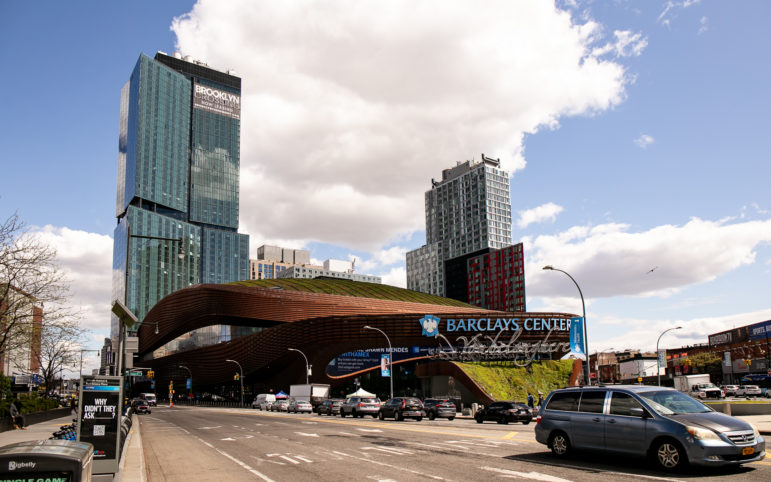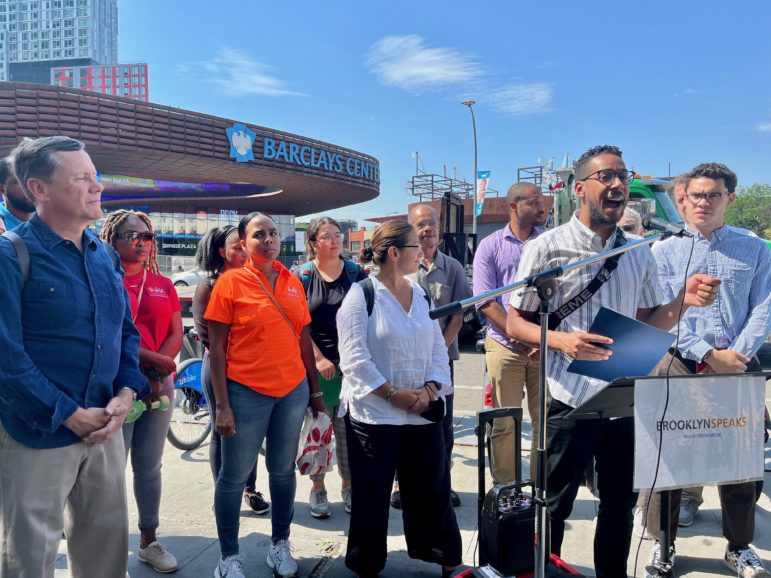The developer’s failed promise to build a glass-enclosed public plaza in front of the Barclays Center is a bad sign for its other pledges to the community yet to be fulfilled: Most importantly, the 877 units of affordable housing still unbuilt, advocates and officials say.

Adi Talwar
The Barclays Center in downtown Brooklyn.More than a decade ago, when the state was modifying the terms of the Atlantic Yards project—the ongoing downtown Brooklyn development that now contains the Barclays Center, and a series of glassy apartment towers known as Pacific Park—the builders behind the site pledged to create “a significant public amenity comprised of a large, glass-enclosed public space,” between the arena and the nearby subway entrance.
“Imagine that we’re all standing here, looking at a soaring glass atrium, its main floor rises 15 to 20 feet above the street level. And we could walk across the street and walk into it through a nice, elegant set of stairs leading from the corner of Atlantic Avenue and Flatbush Avenue, up into this beautiful climate controlled room,” described Gib Veconi, chair of the Prospect Heights Neighborhood Development Council and a member of Brooklyn Speaks, a community group that’s been organizing around the development project for the last several years.
“Inside there, people would be lingering at tables having a sip of coffee, perhaps there might even be some musician playing there or some other programming going on,” he continued. “This is a place that was known as the ‘Urban Room.'”
But anyone who’s visited the Barclays Center can attest: there is no Urban Room at the site, despite a 2014 agreement between the developers and the state that set a hard deadline for its creation—along with a $10 million penalty if the owners failed to build it in time.
That deadline passed in May. Now, elected officials and community advocates are calling on Gov. Kathy Hochul and Empire State Development, the state entity overseeing the project, to collect on those missed deadline fees. They say doing so is paramount to holding the developers accountable to their public promises—a sore spot when it comes to Atlantic Yards, where an original Community Benefits Agreement inked in 2005 that pledged jobs and affordable housing for the neighborhood was never sufficiently enforced.
READ MORE: When Developers Promise Community Benefits, Who Holds Them Accountable?
“This is yet another example of how public commitments to this project are being set aside by our government in favor of the interests of private developers,” Veconi said.
What’s more, the officials and advocates say, is what the developer’s failure to create the Urban Room portends for its other pledges to the community yet to be fulfilled: Most importantly, the 877 units of affordable housing still unbuilt at the site.
“We’re currently in a housing shortage and a housing crisis in the city of New York. We’ve been tasked with building as much in as many apartments as possible in a short amount of time,” Brooklyn Borough President Antonio Reynoso said at a press conference outside the Barclays Center on Thursday.
There are bigger implications that go beyond just this project, the group stressed, since Empire State Development is the main oversight agency for other high-profile and controversial developments, including a plan to remake Penn Station and the surrounding neighborhood, and another to build a new stadium for the Buffalo Bills upstate.
“When the public has lost all confidence in our ability to negotiate, put together contracts and packages that do not get fulfilled—once one promise gets broken, the confidence for all other promises in the future are broken,” Reynoso said.
The current developers of Atlantic Yards/Pacific Park, Greenland Forest City Partners, have until May of 2025 to build the remaining affordable housing called for in their development agreement. Should they fail to meet that deadline, they’d face a $2,000 penalty for every unit not built, for every month it’s delayed. The new apartments are planned for atop a railyard, requiring a platform to be constructed over an LIRR storage site.
“There’s no way that a developer is going to meet the deadline for those 877 units. We know that today,” said Michelle de la Uz, executive director at the Fifth Avenue Committee, one of several community groups that signed the 2014 agreement that set those penalty terms.
“At this point, I think a lot of people are honestly very rightfully concerned of whether this development will ever be completed,” State Sen. Jabari Bisport said.
The longer construction is delayed, the more longtime residents are being priced out of the neighborhood due to rising rents, particularly New Yorkers of color. In Brooklyn Community District 2, where the project is located, the number of Black residents decreased from 41.8 percent of the population in 2000 to 20.3 percent in 2015-2019, according to a Furman Center analysis. The number of white residents increased during that time from 31.1 percent of the population to 52.1 percent.
Residents of the community boards around Pacific Park are supposed to get preference for the affordable housing built there. “We are losing people, we are pricing people out of this market, out of the four community boards that are supposed to get the preference,” Assemblymember Jo Ann Simon said.

Jeanmarie Evelly
Brooklyn Borough President Antonio Reynoso speaks at a press conference calling for the state to enforce the provisions of the Pacific Park/Atlantic Yards development agreement.Empire State Development did not directly respond when asked if it would be collecting the penalty fees from the developer for failing to meet the May deadline to construct the Urban Room. In a statement, both ESD and Greenland Forest City Partners pointed to the popularity of the current space in front of the Barclays Arena where the structure was slated to be built. That plaza became a meeting point for civil rights protests during the summer of 2020 in the wake of George Floyd’s murder.
“We have heard loud and clear from locals, visitors and public officials that Brooklyn’s public square is a far better civic space for Brooklyn residents, transit riders, and visitors to Barclays Center than the enclosed atrium originally planned for this site,” a spokesperson from Greenland Forest City Partners said.
“Pacific Park Brooklyn is unmatched in its successful delivery of affordable housing, transit and infrastructure improvements, and a world-class arena,” the statement continued. “While we continue with our next phases of the project over the railyard, we hope to work with the State and our neighbors to ensure the plaza is protected and that development planned for this site can be re-imagined elsewhere in Pacific Park.”
A spokesperson for ESD said the agency “acknowledges the importance of ensuring that this developer honors the commitments it promised to the community.”
“ESD will work with the developer and the community to expand access to public space and advance the next phases of this critical project,” the spokesperson added.
Critics say the actual construction of the Urban Room is somewhat beside the point, and what’s really at stake is the state’s willingness to hold the developer accountable to the provisions it promised community groups in that 2014 agreement.
The Urban Room was supposed to be built at the same time as the Barclays Center, according to Veconi. Building such an enclosure wouldn’t be feasible now, considering the heavy foot traffic the now-operating arena brings to the space (and Greenland Forest City Partners no longer owns the venue itself, which has been sold twice since the project first began).
“It wasn’t supposed to be this way. But it’s how it turned out. Because the project commitments have always been less important to Empire State Development than what is good for the developer,” Veconi said.
John Medina, an organizer with the 32BJ union and third-generation resident of the area, said he’s been watching the Atlantic Yards saga play out and transform the community over the last two decades. Developers, he said, will “say everything under the sun” to get their project approved.
“But then later, there’s no oversight committee,” he added, saying he’s one of the few longtime residents of his old neighborhood still around. “People are moving out from here in droves because of these developments.”









4 thoughts on “Pledged Amenity Space at Atlantic Yards Was Never Built. What Will That Mean for Promised Affordable Housing?”
The Urban Room was always a bad idea–these efforts toward accountability would be much better placed at getting the current owners Brooklyn Events Center to (1) get Flatbush Ave access to the plaza restored ASAP (their “plaza improvement” currently happening has made this a nightmare for everyone south on 5th Ave corridor that uses that station) and (2) to treat the plaza as a public space, and not as their private entrance system. I used to use this station daily and the kettling gates forced residents to often walk much further out of their way to get to and from the subway because the Barclays folks thought of the plaza as their own personal security check point. During the depths of covid, they had so much of the plaza and subway entrances cordoned off that you had to walk two blocks away to the entrance at 4th & Atlantic just to get in.
The affordable housing issue is important and should be enforced–80% of the construction was supposed to be affordable and we should hold them to it. Right now, there is marginal affordability still in the first Dean Street buildings, and good affordability in the newer Pacific Street building they put up, as well as 100% market rates in the new Brooklyn Crossing that Brodsky is running. The rest of the park is supposed to be affordable. Get those buildings up!
But people arguing over the “Urban Room”—just stop. It’s not worth the hot air expended to even discuss.
Empire State Development has f’d up this project since day 1. With political cronies like Ken Adams (note how on earth did he land a job with CUNY) and other fly by night ESD employees who had no previous background in housing, project management, design or construction. The turnover at this agency is too high for them to oversee any type of project. The Atlantic Yards Community Development Corp has been a mess since day one.
Forest Ratner should be sued
Cuomo allowed this dysfunction since he allowed ESD to run this project with his political cronies who knew nothing about housing but their own.
Urban room, can we live in a urban room, No, the lack of low income units should really be the issue, by the time this project is finish black and brown people in the surrounding area will be already pushed out, have preference for those who been displaced from these communities, the MOST of our politicians have once again failed the people in favor of the real estate developers, But they want your Vote